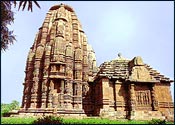|
|
|
|
|
|
|
|
|
| Bhubaneswar Introduction |
|
 The capital of the East Indian state of Orissa, Bhubaneswar derives its name from the Sanskrit word Tribhuvaneswara, which stands for Lord Shiva. The area around Bhubaneswar constituted the famed kingdom of Kalinga, which was conquered after a bloody battle by Ashoka, the great Mauryan emperor. Appalled at the carnage, Ashoka renounced violence and embraced Buddhism. Against this multi-hued tapestry of history, and the backdrop of the soaring sandstone spires of old Bhubaneswar, a new capital has taken shape. The capital of the East Indian state of Orissa, Bhubaneswar derives its name from the Sanskrit word Tribhuvaneswara, which stands for Lord Shiva. The area around Bhubaneswar constituted the famed kingdom of Kalinga, which was conquered after a bloody battle by Ashoka, the great Mauryan emperor. Appalled at the carnage, Ashoka renounced violence and embraced Buddhism. Against this multi-hued tapestry of history, and the backdrop of the soaring sandstone spires of old Bhubaneswar, a new capital has taken shape. |
|
|
Top ˆ |
|
|
| Bhubaneswar Tourist Attractions |
|
|
| § Parashurameshwara Temple |
|
Parashurameshwara Temple (650 A.D.) is one of the best examples of the Orissa style of temple architecture. This temple followed very rigid parameters set by the ritualistic books. The temple has some exquisite carvings and sculpture. |
|
|
| § Vaital Deul |
|
Vaital Deul (800 A.D.) has a double-storied wagon roof, which in turn is an influence of the Buddhist cave architecture. The interior of the temple has the image of Chamunda (an incarnation of Goddess Kali). |
|
|
| § Rajarani temple |
|
The Rajarani Temple (1100 A.D.), which derives its name from the stone known as the Rajarani, was built earlier in comparison to the impressive Lingaraja. Set amongst picturesque paddy fields, the relatively small Rajarani temple is noted for its fascinating female figures portrayed in a stunning variety of amorous poses and moods. |
|
|
| § State Museum |
|
The Orissa State Museum is one of the best places to explore sculptures, stone inscriptions, lithic and bronze-age tools, rare copper plates, palm-leaf manuscripts, paintings, anthropological specimens, and musical instruments. |
|
|
|
|
Top ˆ |
|
|
|
|











